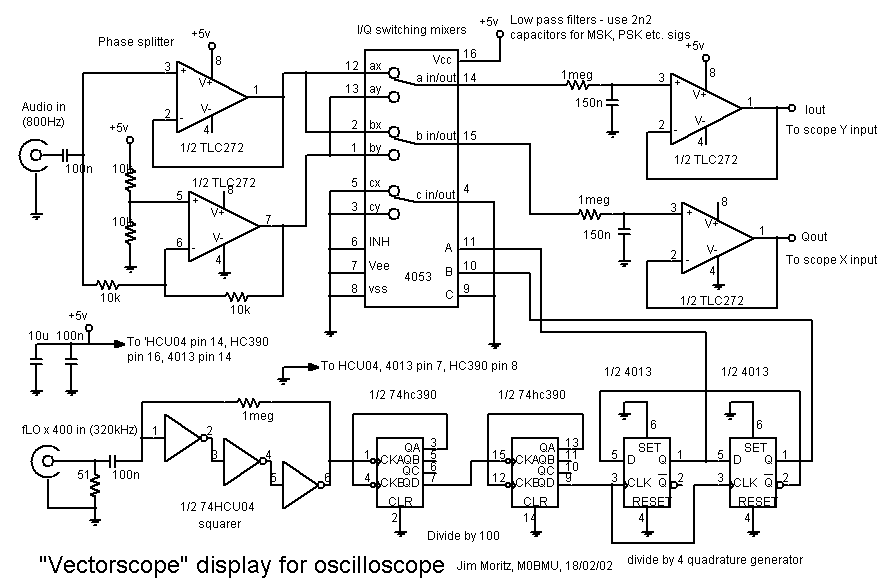Feature
Vectorscope Display by Jim Moritz.
It isn't meant to be a finished design, but certainly works fine as it is. As well as this circuit, you will need an oscilloscope capable of displaying in X/Y mode, and a reference "LO" signal source.

In-phase and Quadrature reference square wave signals are generated by a divide by 4, 2 bit ring counter using 2 D type flip - flops. So that I could use an RF generator as the reference source, the /4 is preceded by a /100 counter, so the reference signal input is at 320kHz for 800Hz audio input. Dividing down the generator output also allows adjusting the reference frequency in small fractions of a Hz, which is necessary to stabilise the display, unless reference and signal are phase-locked. The squarer circuit shown works with a few 10s of mV or more input. A DDS or other synthesizer is ideal, a stable VFO would be OK too. If you have a signal source that generates audio frequency quadrature outputs, the dividers are not required obviously.
The I and Q reference signals drive two mixers, which are 2 analogue switches in a 4053 (sound familiar, Johan!). The input phase splitter circuit generates a push-pull signal for the mixers. The mixer outputs are filtered by single R/C low pass sections, which are adequate for casual experiments, and makes it easy to experiment with different bandwidths. A 1Hz or less bandwidth should be best for G4JNT's 10s dot periods; to look at "normal" modulated signals like FSK or MSK, wider bandwidth is needed for the display to follow the signal, as shown on the diagram - 1meg/2n2 (70Hz) is about the limit before the display becomes excessively blurred by the 2f signal at the mixer output.. For better noise rejection, higher order low pass filters could be used. The outputs are buffered by 2 op-amp followers, which are not strictly necessary if only a 'scope is to be connected to the output.
The circuit as shown runs on a single 5V supply - it requires low voltage type op-amps, the CMOS ones shown are fine. 741s and the like definitely won't work - unless you use a split rail power supply for the analogue parts. This would actually be better, since this would remove the +2.5V DC offset on the outputs that exists at the moment. If you do this use +/- 5V, and connect the -5V rail to the negative supply pins of all the op-amps, and to the Vee pin of the 4053. also, connect the non-inverting input of the lower op-amp in the phase splitter to 0V. The maximum total supply you can apply to the 4053 is 15V.
The input audio signal should be a few V pk-pk. The output will be the same amplitude as the input, so the scope should be set to 1 or 2V/div. With no input signal, set the scope controls so that the spot is in the centre of the screen. If a CW signal is applied, the distance the dot moves from the centre is the amplitude, whilst the phase difference is the angle between a vertical line and a line drawn between the centre of the screen and the spot. If a CW signal is applied with a slight frequency difference, the spot orbits around the centre of the screen in a circle. The display shows the phase trajectory of an angle modulated signal, which can be quite intricate with MSK.
Cheers, Jim Moritz
73 de M0BMU
Note: to save the picture, right-mouseclick and choose "save picture as"